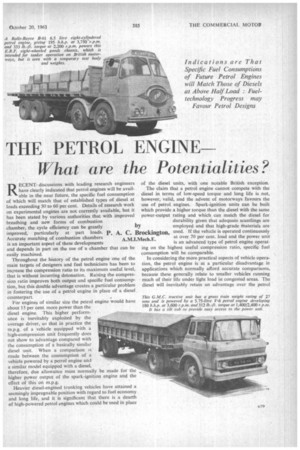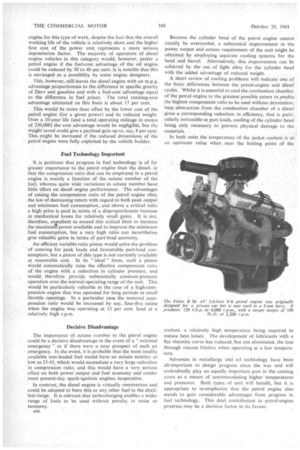THE PETROL ENGINE—
Page 73

Page 74

If you've noticed an error in this article please click here to report it so we can fix it.
What are the Potentialities?
RECENT. discussions with leading research engineers have clearly indicated that petrol engines will be available in the near future, the specific fuel consumption of which will match that of established types of diesel at loads exceeding 50 to 60 per cent. Details of research work on experimental engines are not currently available, but it has been stated by various authorities that with improved breathing and new forms of combustion chamber, the cycle efficiency can be greatly improved, particularly at part loads. Accurate matching of combustion chambers is an important aspect of these developments and depends in part on the use of a chamber that can be easily machined.
Throughout the history of the petrol engine one of the main targets of designers and fuel technicians has been to increase the compression ratio to its maximum useful level, that is without incurring detonation. Raising the compression ratio improves both output and specific fuel consumption, but this double advantage creates a particular problem in fostering the use of a petrol engine in place of a diesel counterpart .
For engines of similar size the petrol engine would have about 15 per cent, more power than the diesel engine. This higher performance is inevitably exploited by the average driver, so that in practice the m.p.g. of a vehicle equipped with a high-compression unit frequently does not show to advantage compared with the consumption of a basically similar diesel unit. When a comparison is made between the consumption of a vehicle powered by a petrol engine and a similar model equipped with a diesel, therefore, due allowance must normally be made for the higher power output of the spark-ignition engine and the effect of this on m.p.g.
Heavier diesel-engined trunking vehicles have attained a seemingly impregnable position with regard to fuel economy and long life, and it is significant that there is a dearth of high-powered petrol engines which could be used in place of the diesel units, with one notable British exception.
The claim that a petrol engine cannot compete with the diesel in terms of low-speed torque and long life is not, however, valid, and the advent of motorways favours the use of petrol engines. Spark-ignition units can be built which provide a higher torque than the diesel with the same power-output rating and which can match the diesel for durability given that adequate scantlings are employed and that high-grade materials are used. If the vehicle is operated continuously at over 70 per cent, load and the power unit is an advanced type of petrol engine operating on the highest useful compression ratio, specific fuel consumption will be comparable.
In considering the more practical aspects of vehicle operation, the petrol engine is at a particular disadvantage in applications which normally afford accurate comparisons, because these generally relate to smaller vehicles running much of their life under light load in congested areas. The diesel will inevitably retain an advantage over the petrol Mech.E.
engine for this type of work, despite the fact that the overall working life of the vehicle is relatively short and the higher first cost of the power unit represents a more serious depreciation factor. The majority of operators of diesel engine vehicles in this category would, however, prefer a petrol engine if the fuel-cost advantage of the oil engine could be reduced by 30 to 40 per cent. It is notable that this is envisaged as a possibility by some engine designers.
This, however, still leaves the diesel engine with an m.p.g. advantage proportionate to the difference in specific gravity of Dery and gasoline and with a fuel-cost advantage equal to the difference in fuel prices. The total running-cost advantage estimated on this basis is about 17 per cent.
This would be more than offset by the lower cost of the petrol engine (for a given power) and its reduced weight. Over a 10-year life (and a total operating mileage in excess of 250,000) the cost advantage would be negligible, but the weight saved could give a payload gain up to, say, 8 per cent. This might be increased if the reduced dimensions of the petrol engine were fully exploited by the vehicle builder.
Fuel Technology Important
It is pertinent that progress in fuel technology is of far greater importance to the petrol engine than the diesel, in that the compression ratio that can be employed in a petrol engine is mainly a function of the octane number of the fuel, whereas quite wide variations in cetane number have little effect on diesel engine performance. The advantages of raising the compression ratio of the petrol engine obey the law of decreasing return with regard to both peak output and minimum fuel consumption, and above a critical ratio a high price is paid in terms of a disproportionate increase in mechanical losses for relatively small gains. It is not, therefore, expedient to exceed this critical limit to increase the maximuffi power available and to improve the minimum fuel consumption, but a very high ratio can nevertheless give valuable gains in terms of part-load economy.
An efficient variable-ratio piston would solve the problem of catering for peak loads and favourable part-load consumption, but a piston of this type is not currently available at reasonable cost. In its " ideal " form, such a piston would automatically raise the effective compression ratio of the engine with a reduction in cylinder pressure, and would therefore provide substantially constant-pressure operation over the normal operating range of the unit. This would be particularly valuable in the case of a high-compression engine that was operated for long periods at small throttle openings. In a particular case the nominal compression ratio would be increased by say, four-five ratios when the engine was operating at 15 per cent. load at a relatively high r.p.m.
Decisive Disadvantage
The importance of octane number to the petrol engine could be a decisive disadvantage in the event of a " national emergency" or if there were a near prospect of such an emergency. In the event, it is probable that the most readily available non-leaded fuel would have an octane number as low as 2545, which would necessitate a very large reduction in compression ratio, and this would have a very serious effect on both power output and fuel economy and render most present-day spark-ignition engines inoperative.
In contrast, the diesel engine is virtually omniverous and could be adapted to burn this or any other fuel in the distillate range. It is relevant that turbocharging enables a wider range of fuels to be used without penalty in noise or economy.
R40
Because the cylinder head of the petrol engine cannot usually be overcooled, a substantial improvement in the power output and octane requirement of the unit might be obtained by employing separate cooling systems for the head and barrel. Alternatively, this improvement can be achieved by the use of light alloy for the cylinder head with the added advantage of reduced weight.
A short review of cooling problems will indicate one of the basic differences between the petrol-engine and diesel cycles. Whilst it is essential to cool the combustion chamber of the petrol engine to the greatest possible. extent to enable the highest compression ratio to be used without detonation, heat abstraction from the combustion chamber of a diesel gives a corresponding reduction in efficiency, that is particularly noticeable at part loads, cooling of the cylinder head being only necessary to prevent physical damage to the materials.
In both units the temperature of the jacket coolant is at an optimum value when near the boiling point of the coolant, a relatively high temperature being required to reduce heat losses. The development of lubricants with a flat viscosity curve has reduced, but not eliminated, the loss through viscous friction when operating at a low temperature.
Advances in metallurgy and oil technology have been all-important to design progress since the war and will undoubtedly play an equally important part in the coming years as a means of accommodating higher temperatures and pressures. Both types of unit will benefit, but it is appropriate to 're-emphasize that the petrol engine also stands to gain considerable advantages from progress in fuel technology. This dual contribution to petrol-engine progress may be a decisive factor in its favour.




































































































































